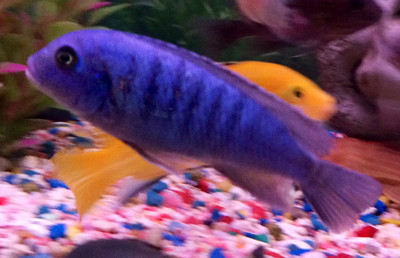Dolphin Cichlid (Cyrtocara moorii)
Posted by Max Gandara on on 7th May 2025
Dolphin Cichlid (Cyrtocara moorii): The Gentle Giant of Lake Malawi
With its graceful movements, shimmering blue hues, and distinctive forehead hump, the Dolphin Cichlid — also known as the Blue Dolphin Cichlid — is one of the most majestic freshwater fish you can add to a cichlid tank. Native to Lake Malawi in East Africa, this species offers a mix of peaceful temperament and regal appearance, making it a standout choice for aquarists ready to explore the world of African cichlids.
Overview: What is a Dolphin Cichlid?
-
Scientific Name: Cyrtocara moorii
-
Common Names: Blue Dolphin Cichlid, Malawi Dolphin, Hump-head Cichlid
-
Origin: Lake Malawi, Africa
-
Size: Up to 8–10 inches (20–25 cm) in captivity
-
Lifespan: 8–10 years (with proper care)
-
Temperament: Generally peaceful, especially for a cichlid
-
Coloration: Soft, powdery blue with a characteristic nuchal hump (more pronounced in males)
These fish are named for their streamlined bodies and rounded heads, which resemble a dolphin — especially as they glide effortlessly through the water.
Natural Habitat
In Lake Malawi, Dolphin Cichlids inhabit sandy or muddy bottoms, often in deeper, open waters. They're not rock dwellers like many other Malawi cichlids, preferring to sift through sand for food and roam more open swimming space.
Behavior and Temperament
Unlike many of their aggressive mbuna cousins, Cyrtocara moorii is peaceful and social, often thriving in groups and doing well in mixed cichlid communities — provided tankmates are not overly aggressive.
-
Group dynamics: Best kept in groups of 4–6 or more
-
Social structure: Males develop hierarchies; females are more subdued
-
Tank behavior: Curious, slow-moving, and generally non-aggressive
They are slow growers, and their full adult form — including color and hump — takes several years to develop.
Aquarium Requirements
Minimum Tank Size
-
75 gallons for a group, but 100+ gallons is preferred for adult specimens.
Water Conditions
-
Temperature: 24–28°C (75–82°F)
-
pH: 7.8–8.6 (alkaline, to match Lake Malawi’s conditions)
-
Hardness: Moderately hard to hard
Décor and Substrate
-
Substrate: Fine sand is ideal (they like to dig)
-
Décor: Smooth rocks and open swimming areas
-
Avoid sharp decorations and overcrowding
Filtration & Maintenance
-
A powerful filter is essential, as cichlids are messy eaters.
-
Weekly water changes (25–30%) help maintain stability.
Diet
Dolphin Cichlids are omnivores with a preference for protein-rich diets.
Recommended foods:
-
High-quality cichlid pellets or flakes
-
Frozen or live foods: brine shrimp, krill, mysis shrimp, earthworms
-
Occasional greens: spirulina flakes or blanched veggies (zucchini, spinach)
Avoid high-fat or mammalian protein-rich foods like beef heart — they can lead to digestive issues.
Tankmates: What Works (and What Doesn’t)
Despite their size, Dolphin Cichlids are relatively peaceful, so they should be housed with other non-aggressive or semi-aggressive African cichlids of similar size.
Good companions:
-
Peacocks (Aulonocara species)
-
Haps (Placidochromis, Sciaenochromis)
-
Synodontis catfish
-
Larger rainbowfish (in non-cichlid setups)
Avoid:
-
Mbuna (too aggressive and territorial)
-
Small, delicate fish (may be mistaken for food)
-
Fin-nipping species
Breeding
Dolphin Cichlids are mouthbrooders — the female carries fertilized eggs in her mouth until they hatch, usually within 3 weeks.
-
Provide flat stones or open sand areas for spawning
-
Males display and entice females to lay eggs
-
Remove fry to a separate tank for higher survival rates
Breeding requires patience and a stable group, but it's rewarding and often occurs naturally in mature setups.

